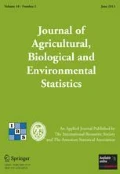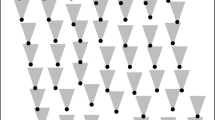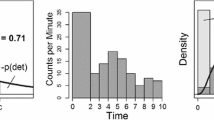Abstract
Detection/non-detection data are increasingly collected in continuous time, e.g., via camera traps or acoustic sensors. Application of occupancy modeling approaches to these datasets typically requires discretizing the dataset to detections over individual days or weeks, which precludes analysis of temporal interactions between species or covariate relationships that change over fine temporal scales. To address this limitation, we developed a two-species occupancy model that assumes a temporal point process detection model. This model permits simultaneous analysis of species interactions in space (i.e., site occupancy) and time (i.e., activity patterns). The model is also capable of estimating the amount of time animals are available for detection, i.e., availability. We applied the model to detections of white-tailed deer (Odocoileus virginianus) and coyote (Canis latrans) collected via camera trapping. We found evidence of both temporal and spatial interactions between deer and coyote. Detection intensity of deer was greater and proportionally more diurnal where coyotes were present. At hunted sites, coyotes were more likely to occur at sites where deer were also present (and vice versa). These results highlight how two-species occupancy models with a continuous-time detection process can be used to infer temporal interactions between species. Our approach broadens the set of questions ecologists can ask regarding both spatial and temporal interactions between species, as well as fine-scale temporal covariates (e.g., weather). Our model should be increasingly applicable given the increasing availability of ecological data collected in continuous time. Supplementary materials accompanying this paper appear on-line



Similar content being viewed by others
References
Ait Kaci Azzou S, Singer L, Aebischer T, Caduff M, Wolf B, Wegmann D (2021) A sparse observation model to quantify species distributions and their overlap in space and time. Ecography. https://doi.org/10.1111/ecog.05411
Acevedo MA, Villaneuva-Rivera LJ (2006) From the field: Using automated digital recording systems as effective tools for the monitoring of birds and amphibians. Wildl Soc B 34:211–214
Ballard WB, Whitlaw HA, Young SJ, Jenkins RA, Forbes GJ (1999) Predation and survival of white-tailed deer fawns in Northcentral New Brunswick. J Wildl Manag 63:574–579
Beier P, McCullough DR (1990) Factors influencing white-tailed deer activity patterns and habitat use. Wildl Monogr 109:3–51
Borchers DL, Distiller G, Foster R, Harmsen B, Milazzo L (2014) Continuous-time spatially explicit capture-recapture models, with an application to a jaguar camera-trap survey. Methods Ecol Evol 5:656–665
Burton AC, Neilson E, Moreira D, Ladle A, Steenweg R, Fisher JT, Bayne E, Boutin S (2015) Wildlife camera trapping: a review and recommendations for linking surveys to ecological processes. J Appl Ecol 5:675–685
Carpenter B, Gelman A, Hoffman MD, Lee D, Goodrich B, Betancourt M, Brubaker M, Guo J, Li P, Riddell A (2017) Stan: a probabilistic programming language. J Stat Soft 76:1–32
Chao A (2001) An overview of closed capture-recapture models. J Agr Biol Envir St 6:158–175
Cherry MJ, Conner LM, Warren RJ (2015) Effects of predation risk and group dynamics on white-tailed deer foraging behavior in a longleaf pine savanna. Behav Ecol 26:1091–1099
Choquet R (2018) Markov-modulated Poisson processes as a new framework for analysing capture-recapture data. Methods Ecol Evol 9:929–935
Cressie N, Wikle CK (2011) Statistics for spatio-temporal data. Wiley, Hoboken, NJ
Cromsigt JP, Kuijper DP, Adam M, Beschta RL, Churski M, Eycott A, Kerley GI, Mysterud A, Schmidt K, West K (2013) Hunting for fear: innovating management of human-wildlife conflicts. J Appl Ecol 50:544–549
Dai B, Ding S, Wahba G (2013) Multivariate Bernoulli distribution. Bernoulli 19:1465–1483
Dorazio RM, Karanth KU (2017) A hierarchical model for estimating the spatial distribution and abundance of animals detected by continuous-time recorders. PLoS ONE 12:e0176966
Eddelbuettel D, François R, Allaire J, Ushey K, Kou Q, Russel N, Chambers J, Bates D (2011) Rcpp: seamless R and C\(++\) integration. J Stat Soft 40:1–8
Froidevaux JSP, Zellweger F, Bollmann K, Obrist MK (2014) Optimizing passive acoustic sampling of bats in forests. Ecol Evol 24:4690–4700
Garrard GE, Bekessy SA, McCarthy MA, Wintle BA (2008) When have we looked hard enough? A novel method for setting minimum survey effort protocols for flora surveys. Austral Ecol 33:986–98
Guillera-Arroita G, Morgan BJT, Ridout MS, Linkie M (2011) Species occupancy modeling for detection data collected along a transect. J Agr Biol Envir St 16:301–317
Higdon SD, Diggins CA, Cherry MJ, Ford WM (2019) Activity patterns and temporal predator avoidance of white-tailed deer (Odocoileus virginianus) during the fawning season. J Ethol 37:283–290
Kays RW, Gompper ME, Ray JC (2008) Landscape ecology of eastern coyotes based on large-scale estimates of abundance. Ecol Appl 18:1014–1027
Kays R, Parsons AW, Baker MC, Kalies EL, Forrester T, Costello R, Rota CT, Millspaugh JJ, McShea WJ (2016) Does hunting or hiking affect wildlife communities in protected areas? J Appl Ecol 54:242–252
Kays R, Parsons AW, Baker MC, Kalies EL, Forrester T, Costello R, Rota CT, Millspaugh JJ, McShea WJ (2017) Data from: does hunting or hiking affect wildlife communities in protected areas? J Appl Ecol 54:242–252
Kéry M, Schmidt B (2008) Imperfect detection and its consequences for monitoring for conservation. Commun Ecol 9:207–216
Kéry M, Royle JA (2016) Applied Hierarchical Modeling in Ecology: Analysis of Distribution, Abundance, and Species Richness in R and BUGS, vol 1. Prelude and Static Models, Elsevier, Amsterdam
Kilgo JC, Ray HS, Ruth C, Miller KV (2010) Can coyotes affect deer populations in southeastern North America? J Wildl Manag 74:929–933
Kukielka E, Barasona JA, Cowie CE, Drewe JA, Gortazar C, Cotarelo I, Vicente J (2013) Spatial and temporal interactions between livestock and wildlife in south central Spain assessed by camera traps. Prevent Vet Med 112:213–221
Lahoz-Monfort JJ, Morgan BJ, Harris MP, Wanless S, Freeman SN (2011) A capture-recapture model for exploring multi-species synchrony in survival. Methods Ecol Evol 2:116–24
Lahoz-Monfort JJ, Morgan BJT, Harris MP, Daunt F, Wanless S, Freeman SN (2013) Breeding together: modeling synchrony in productivity in a seabird community. Ecology 94:3–10
Langrock R, Borchers D, Skaug HJ (2013) Markov-modulated nonhomogeneous Poisson processes for modeling detections in surveys of marine mammal abundance. J Am Stat Assoc 108:840–851
Lesmeister DB, Nielson CK, Schauber EM, Hellgren EC (2015) Spatial and temporal structure of a mesocarnivore guild in midwestern North America. Wildl Monogr 191:1–61
Lingle S, Pellis S (2002) Fight or flight? Antipredator behavior and the escalation of coyote encounters with deer. Oecologia 131:154–164
Lingle S, Wilson WF (2001) Detection and avoidance of predators in white-tailed deer (Odocoileus virginianus) and mule deer (Ohemionus). Ethology 107:125–147
MacKenzie D, Nichols J, Royle JA, Pollock K, Bailey L, Hines J (2017) Occupancy estimation and modeling: inferring patterns and dynamic of species occurrence, 2nd edn. Academic Press, London
MacKenzie DI, Nichols JD, Lachman GB, Droege S, Andrew Royle J, Langtimm CA (2002) Estimating site occupancy rates when detection probabilities are less than one. Ecology 83:2248–55
McShea WJ, Forrester T, Costello R, He Z, Kays R (2015) Volunteer-run cameras as distributed sensors for macrosystem mammal research. Landscape Ecol 31:55–66
Nichols JD, Bailey LL, O’Connell AF Jr, Talancy NW, Campbell Grant EH, Gilbert AT, Annand EM, Husband TP, Hines JE (2008) Multi-scale occupancy estimation and modelling using multiple detection methods. J Appl Ecol 45:1321–1329
O’Connell AF, Nichols JD, Karanth KU (2011) Camera traps in animal ecology: methods and analyses. Springer, Tokyo
Parsons AW, Bland C, Forrester T, Baker-Whatton MC, Schuttler SG, McShea WJ, Costello R, Kays R (2016) The ecological impact of humans and dogs on wildlife in protected areas in eastern North America. Biol Conserv 203:75–88
Parsons AW, Forrester T, Baker-Whatton MC, McShea WJ, Rota CT, Schuttler SG, Millspaugh JJ, Kays R (2018) Mammal communities are larger and more diverse in moderately developed areas. eLife 7:e38012
Plummer M (2003) JAGS: A program for analysis of Bayesian graphical models using Gibbs sampling. Proc 3rd Int Workshop Distrib Stat Comput 124:1–10
Pollock KH, Winterstein SR, Bunck CM, Curtis PD (1989) Survival analysis in telemetry studies: the staggered entry design. J Wildlife Manag 53:7–15
Pollock LJ, Tingley R, Morris WK, Golding N, O’Hara RB, Parris KM, Vesk PA, McCarthy MA (2014) Understanding co-occurrence by modelling species simultaneously with a Joint Species Distribution Model. Methods Ecol Evol 5:397–406
R Core Team (2020) R: A language and environment for statistical computing. R Foundation for Statistical Computing, Vienna. https://www.R-project.org/
Ramesh T, Kalle R, Sankar K, Qureshi Q (2012) Spatio-temporal partitioning among large carnivores in relation to major prey species in western Ghats. J Zool 287:269–275
Richmond OMW, Hines JE, Beissinger SR (2010) Two-species occupancy models: a new parameterization applied to co-occurrence of secretive rails. Ecol Appl 20:2036–2046
Ridout MS, Linkie M (2009) Estimating overlap of daily activity patterns from camera trap data. J Agr Biol Envir St 14:322–337
Rota CT, Ferreira MAR, Kays R, Forrester TD, Kalies EL, McShea WJ, Parsons AW, Millspaugh JJ (2016) A multi-species occupancy model for two or more interacting species. Methods Ecol Evol 10:1164–1173
Rydén T (1995) Consistent and asymptotically normal parameter estimates for Markov modulated Poisson processes. Scand J Stat 22:295–303
Schliep EM, Gelfand AE, Clark JS, Kays R (2018) Joint temporal point pattern models for proximate species occurrence in a fixed area using camera trap data. J Agr Biol Envir St 23:334–357
Schofield MR, Barker RJ, Gelling N (2018) Continuous-time capture-recapture in closed populations. Biometrics 74:626–635
Schuttler SG, Parsons AW, Forrester TD, Baker MC, McShea WJ, Costello R, Kays R (2017) Deer on the lookout: how hunting, hiking and coyotes affect white-tailed deer vigilance. J Zool 301:320–327
Skaug HJ (2006) Markov-modulated Poisson processes for clustered line transect data. Environ Ecol Stat 13:199–211
Steinmetz R, Seuaturien N, Chutipong W (2013) Tigers, leopards, and dholes in a half-empty forest: assessing species interactions in a guild of threatened carnivores. Biol Conserv 163:68–78
Swihart RK, Pignatello JJ, Mattina MJ (1991) Aversive responses of white-tailed deer, Odocoileus virginianus, to predator urines. J Chem Ecol 17:767–777
Tobler MW, Zúñiga Hartley A, Carrillo-Percastegui SE, Powell GV (2015) Spatiotemporal hierarchical modelling of species richness and occupancy using camera trap data. J Appl Ecol 52:413–421
Tyre AJ, Tenhumberg B, Field SA, Niejalke D, Parris K, Possingham HP (2003) Improving precision and reducing bias in biological surveys by estimating false negative error rates in presence-absence data. Ecol Appl 13:1790–1801
Vreeland JK, Diefenbach DR, Wallingford BD (2004) Survival rates, mortality causes, and habitats of Pennsylvania white-tailed deer fawns. Wildl Soc B 32:542–553
Waddle JH, Dorazio RM, Walls SC, Rice KG, Beauchamp J, Schuman MJ, Mazzotti FJ (2010) A new parameterization for estimating co-occurrence of interacting species. Ecol Appl 20:1467–1475
Wang Y, Allen ML, Wilmers CC (2015) Mesopredator spatial and temporal responses to large predators and human development in the Santa Cruz mountains of California. Boil Conserv 190:23–33
Way JG, Ortega IM, Strauss EG (2004) Movement and activity patterns of eastern coyotes in a coastal, suburban environment. Northeast Nat 11:237–254
Webb SL, Gee KL, Strickland BK, Demarais S, DeYoung RW (2010) Measuring fine-scale white-tailed deer movements and environmental influences using GPS collars. Int J Ecol 2010:1–12
Williamson SJ, Hirth DH (1985) An evaluation of edge use by white-tailed deer. Wildl Soc B 13:252–257
Wimmer J, Towsey M, Roe P, Williamson I (2013) Sampling environmental acoustic recordings to determine bird species richness. Ecol Appl 23:1419–1428
Funding
This research is supported by West Virginia University Davis College of Agriculture, Natural Resources, and Design, University of Missouri, National Science Foundation Grant Nos. 1232442, 1319293, VWR Foundation, U.S. Forest Service, North Carolina Museum of Natural Sciences, Smithsonian Institution and National Institute of Food and Agriculture, US Department of Agriculture, McIntire Stennis Project Grant No. WVA00124
Author information
Authors and Affiliations
Corresponding author
Additional information
Publisher's Note
Springer Nature remains neutral with regard to jurisdictional claims in published maps and institutional affiliations.
Supplementary Information
Below is the link to the electronic supplementary material.
Rights and permissions
About this article
Cite this article
Kellner, K.F., Parsons, A.W., Kays, R. et al. A Two-Species Occupancy Model with a Continuous-Time Detection Process Reveals Spatial and Temporal Interactions. JABES 27, 321–338 (2022). https://doi.org/10.1007/s13253-021-00482-y
Received:
Revised:
Accepted:
Published:
Issue Date:
DOI: https://doi.org/10.1007/s13253-021-00482-y




